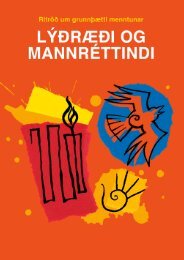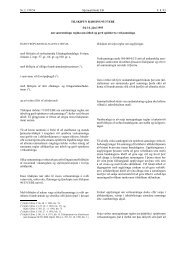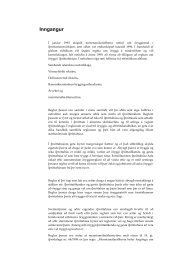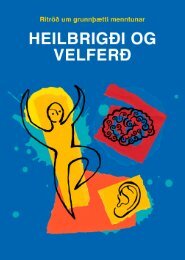Arts and Cultural Education in Iceland : Professor Anne Bamford
Arts and Cultural Education in Iceland : Professor Anne Bamford
Arts and Cultural Education in Iceland : Professor Anne Bamford
Create successful ePaper yourself
Turn your PDF publications into a flip-book with our unique Google optimized e-Paper software.
<strong>in</strong>terrelationship with nature <strong>and</strong> culture. Pioneer work is popular. Icel<strong>and</strong>ic pa<strong>in</strong>ters lift the environment onto a<br />
pedestal. It is a symbol of nationhood <strong>and</strong> the soul of the place. Yet few young artists work with the l<strong>and</strong>scape. Mostly<br />
our successful artists are over 50 years old. Maybe that is because it takes you 10 years to shake the <strong>Arts</strong> Academy<br />
teacher off your back!<br />
I went to the graduate show to look for artists to represent, but the work was so bad. Only one artist showed<br />
potential. We have wanted to go to the Art Academy <strong>and</strong> talk about the commercial side of the art <strong>in</strong>dustry, but we<br />
have never been <strong>in</strong>vited. We used to go to <strong>in</strong>ternational art fairs <strong>and</strong> be very successful, but we are an <strong>in</strong>dependent<br />
gallery <strong>and</strong> so don’t get grants to do this work. Icel<strong>and</strong>ic pa<strong>in</strong>t<strong>in</strong>gs generally sell well with average prices around<br />
400,000-600,000 ISK. But then we take a commission <strong>and</strong> there is tax so the artist gets 57% of sales.<br />
Where creative <strong>in</strong>dustry courses are available, these are popular, especially when they relate<br />
to unique aspects of Icel<strong>and</strong>ic culture such as bespoke adventure travel <strong>and</strong> fashion <strong>and</strong> textiles:<br />
At the department Rural Tourism <strong>in</strong> Hólar University College a range of Icel<strong>and</strong>ic specific cultural tourism courses<br />
at the Bachelor <strong>and</strong> Masters level are offered, such as horse tourism <strong>and</strong> traditional cultural h<strong>and</strong>icrafts.<br />
Vignette 4.6.2 The dem<strong>and</strong> for our courses is very strong<br />
We made our own curriculum. It <strong>in</strong>cludes pr<strong>in</strong>t<strong>in</strong>g, weav<strong>in</strong>g <strong>and</strong> fabric design. We currently have 76 students. It is<br />
hard for our pupils to f<strong>in</strong>d a career pathway <strong>in</strong> Icel<strong>and</strong>. Only about 15 students end up <strong>in</strong> Icel<strong>and</strong>. The rest f<strong>in</strong>d places<br />
overseas. Some become textile teachers <strong>in</strong> Denmark or Spa<strong>in</strong>. We have a few graduates that have gone on to create<br />
their own label. One is a jewellery designer for H&M. Others work <strong>in</strong> London or New York. There are factories <strong>in</strong> Ch<strong>in</strong>a<br />
mak<strong>in</strong>g Icel<strong>and</strong>ic jewellery. Our textile course <strong>in</strong>cludes a lot of f<strong>in</strong>e arts <strong>and</strong> draw<strong>in</strong>g. This is the basis for everyth<strong>in</strong>g.<br />
Then we cover textile pa<strong>in</strong>t<strong>in</strong>g; weav<strong>in</strong>g; tapestry; dye<strong>in</strong>g; pattern mak<strong>in</strong>g <strong>and</strong> cutt<strong>in</strong>g; embroidery; <strong>and</strong> mixed media.<br />
We have a f<strong>in</strong>al exhibition. It is open to the public but students are not allowed to sell their work. We do studio visits<br />
whenever possible, but there are not any work placements. We try to get key speakers <strong>and</strong> <strong>in</strong>dustry people <strong>in</strong>to the<br />
classes too. We expect the students to visit a gallery at least once a year <strong>and</strong> write a paper on it. We have done a<br />
number of collaborative projects with other arts schools throughout Europe funded from Nordic Council money. The<br />
students come to us with very, very different skills levels. So much depends on the quality of the teacher they had <strong>in</strong><br />
secondary school. The dem<strong>and</strong> for our courses is very strong. We have to turn away about 80-100 students each year.<br />
The best th<strong>in</strong>g is that all the lecturers are also practic<strong>in</strong>g artists <strong>and</strong> this makes it a much stronger course. Most of our<br />
staff have masters’ degrees. We make full use of new technologies (<strong>and</strong> this is evident as you walk around the school)<br />
Similarly, tourist <strong>in</strong>itiatives that comb<strong>in</strong>e culture with the unique natural features of Icel<strong>and</strong><br />
appear to be particularly successful. For example:<br />
The whale watch<strong>in</strong>g <strong>in</strong>dustry only began <strong>in</strong> 1995. We now attract over 40,000 visitors per year. We see our role<br />
as education <strong>and</strong> research as much as tourism. Once aga<strong>in</strong>, there is a lack of market research too. We have done<br />
some <strong>and</strong> shown that the travellers are ma<strong>in</strong>ly <strong>in</strong>dependent travellers (come of their own), but there is a lack of<br />
accommodation <strong>and</strong> that is a problem. We are look<strong>in</strong>g at develop<strong>in</strong>g a tourist shop. Last year we tried it <strong>and</strong> the<br />
local craftspeople <strong>and</strong> h<strong>and</strong>icraft people made th<strong>in</strong>gs. It was very popular but we ran out of stock. We do an<br />
exhibition dur<strong>in</strong>g the whale festival, but this is not a chance to sell th<strong>in</strong>gs. Some local performers also perform <strong>in</strong><br />
restaurants dur<strong>in</strong>g the whale season.<br />
In terms of government policy, grants for the arts are allocated on a regional basis through<br />
<strong>Cultural</strong> Agreements, as the follow<strong>in</strong>g <strong>in</strong>formation shows:<br />
Vignette 4.6.3 About <strong>Cultural</strong> Agreements<br />
<strong>Cultural</strong> Agreements have been signed between 7 areas, cover<strong>in</strong>g all of Icel<strong>and</strong>. The agreements are between<br />
the M<strong>in</strong>istry of <strong>Education</strong> <strong>and</strong> Culture <strong>and</strong> the M<strong>in</strong>istry of Communications, <strong>and</strong> between the municipalities<br />
compris<strong>in</strong>g these 7 areas. The gist of these agreements is that each area agrees to fund culture <strong>and</strong> cultural tourism<br />
<strong>in</strong> the area to no less than the agreed amount (matched fund<strong>in</strong>g). In turn, the m<strong>in</strong>istries agree to fund each area to a<br />
particular amount. For example, the <strong>Cultural</strong> Agreement was signed with the West Fjords on June 10, 2007 <strong>and</strong> it will<br />
last until Dec. 31 2009. Accord<strong>in</strong>g to the agreement the two m<strong>in</strong>istries agree that state fund<strong>in</strong>g to culture <strong>and</strong> cultural<br />
tourism <strong>in</strong> the area will not fall below the follow<strong>in</strong>g:<br />
2007: 30 million ISK<br />
2008: 32 “ “<br />
2009: 33 “ “<br />
The municipalities agree that their total fund<strong>in</strong>g for culture <strong>and</strong> cultural tourism <strong>in</strong> the area would not fall below:<br />
2007: 85 millions ISK<br />
101



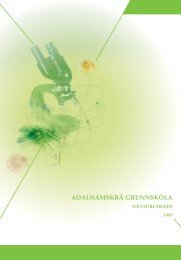
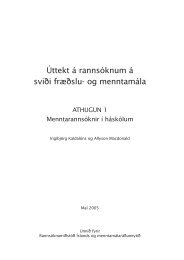

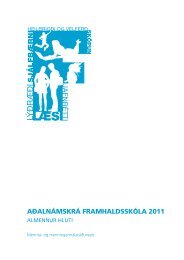
![Aðalnámskrá tónlistarskóla : rytmÃsk tónlist [Eingöngu á rafrænu formi]](https://img.yumpu.com/50843672/1/184x260/aaalnamskra-tanlistarskala-rytma-sk-tanlist-eingangu-a-rafranu-formi.jpg?quality=85)
